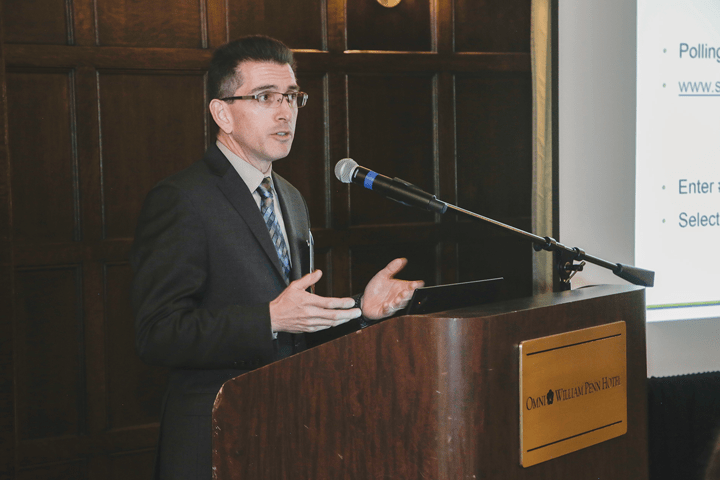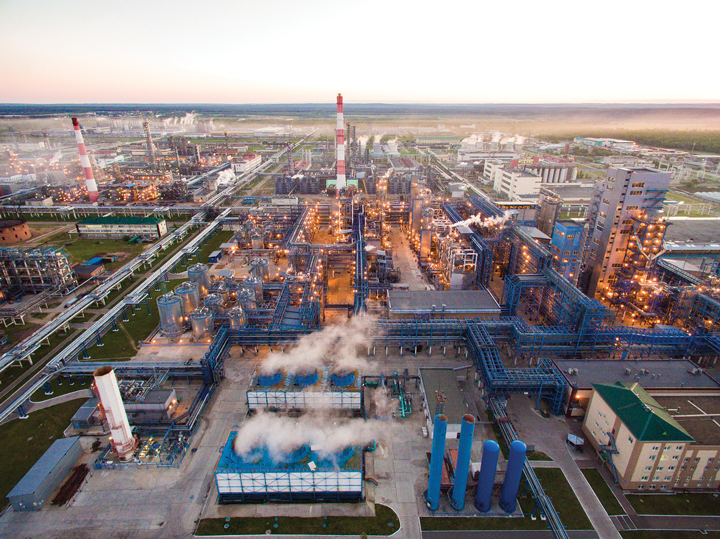Little Wonder
Adam Duckett speaks to chemical engineer Bill Grieco, CEO of the RAPID Manufacturing Institute, about its efforts to accelerate process intensification
JUST over two years ago, the US Department of Energy (DoE) established the Rapid Advancement in Process Intensification Deployment (RAPID) Manufacturing Institute. This public-private partnership between the DoE’s Advanced Manufacturing Office and the American Institute of Chemical Engineers (AIChE) was designed to be industry-led with considerable participation from academics, government labs and other non-profit members. Together these diverse stakeholders are working to reengineer chemical and industrial processes to bring about greater efficiencies in cost, energy consumption, modular scale, sustainability and safety.
The man helping member companies and universities think big and sweat the small stuff is Bill Grieco, who took the helm as RAPID CEO in August last year. The Chemical Engineer caught up with Grieco to get his views on the state of play in process intensification.
First off, the definition of process intensification differs by source. What appears to be universally agreed is that it results in substantially smaller operations that are more efficient and safe; and includes an integrative approach that considers the wider objectives of a process rather than the separate performance of its individual unit operations. RAPID has broadened this further to also focus on the development of standardised modular components and other hardware prototypes that can increase efficiencies.
“I think of process intensification as one of a couple of things,” Grieco says. “The integration of multiple transformations – physical and chemical – into one system that operates simultaneously. That’s the systems level approach. The other definition is…it’s the better matching of timescales of all the transformations; so that’s more the fundamental level.
“Intensification, to me, means you get the chemistry, the mass transfer, and the heat transfer to happen on a well-matched timescale so that none of the individual steps is inherently limiting the other. That allows the engineer to take advantage of different design considerations and integrations of processes in ways that haven’t been possible before.”

A unique time
Grieco has worked across sectors including specialty chemicals, pharma, biomass, and energy. Before joining RAPID he worked in process development at a contract research organisation.
“The threads of technology development throughout my career have been around process development, so working from the laboratory through pilot, and through commercial deployment of new process technologies. I’ve seen the positives of how chemical engineers – like myself and my colleagues – have designed and scaled processes over the years. I’ve also seen times where the potential benefits of process intensification or modularisation really would have been much better in field applications, but the industry was not quite ready for it.”
“I don’t know if it’s a generational shift, an educational shift, a greater sustainability shift or just a unique convergence of technologies but the industry seems more amenable to accepting modular technologies or multiple unit operations collapsed into one process.”
But he thinks something feels different right now in the process industries. Perhaps it’s a unique time in industry where there is a chance to push ahead with process intensification.
“I don’t know if it’s a generational shift, an educational shift, a greater sustainability shift or just a unique convergence of technologies but the industry seems more amenable to accepting modular technologies or multiple unit operations collapsed into one process.”
Grieco points to reactive distillation as an example of process intensification that is already in use. The process, used among others for esterification and etherification, eliminates the need for a separate step to remove the product from the reactants. However, this has been in commercial use since the 1980s, so naturally the question that follows is why have we not seen more intensified processes deployed since?
We have to rewind time and appreciate that for decades, unit operations have helped chemical engineers think about physical and chemical transformations in a simpler way, Grieco explains.
“What has changed since then? We have intensive computing power. Collection of data and storage of data is very inexpensive. We can think about, we can model, we can evaluate options in a way that is dramatically different today than in the past.
“I think we’re at a point now where we can step back from the unit operation and go one step upstream to the physics and chemistry and start to think about the transformations themselves, and think about putting them together in different ways.”
Grieco says that one reason why process intensification has not moved faster is because “it was frankly too routine for engineers like myself and others to continue thinking in terms of traditional unit operations. “It is how we were trained, it was a standard simplification, it’s what the industry and what all of us were very comfortable with. And frankly it was a lower-risk option to continue doing what we always did.”
A RAPID overview
RAPID has 76 members, including BASF, Dow Chemical, ExxonMobil, Fluor, Shell, Process System Enterprise, MIT, GeorgiaTech, and the National Renewable Energy Laboratory.
60% of its members are working on 36 selected projects: 34 technical R&D and two education and workforce development projects.
Among the projects currently being undertaken, RAPID members are developing a general theoretical framework for process intensification; and coupling intensified reaction and heat transfer in a novel reactor to modularise sugar production from biomass.
To date US$70m in funding from the US DoE and more than US$85m in private sector funding is committed through to 2022.
Distributed resources
Fast forward to today and chemical engineers have a greater ability to dissect problems at a fundamental level. Couple this with the wider conversation taking place about the promise of Industry 4.0, and we find business leaders are more amenable to considering new ways of doing things, Grieco says.
“There’s a greater acceptance that decentralised or distributed manufacturing is more likely to be economical or has an opportunity to be more economical today than it did in the past. Part of that is because some of the resources – the raw material resources of interest – are distributed.”

This includes two areas that RAPID and its members are focussing on: natural gas, which is spread across the country in small pockets thanks to the US fracking boom, and bioproducts.
“One of our members is deploying modular technology for desulfurisation of sour gas from the wellhead. If they can upgrade the quality of that natural gas by removing the sulfur at the point of generation, they can inherently upgrade the value of it and make it more economic.”
“Taking that to the next step, if a company were to develop a modular technology or an intensified technology that could then upgrade the natural gas to a higher value product…that further allows the wellhead to be more advantageous and more profitable.”
Grieco says that one of the reasons that biomass as a feedstock for energy and chemicals has not taken off is because industry has been locked into typical chemical and process engineering thinking: ie build a large centralised biorefinery.
“The challenge is getting all the low-density biomass to that site in a cost-effective way. It costs a lot of money and takes a lot of effort to secure the biomass in a region, and it has inherently lower density unless you grind it up and make it into wood pellets.”
Intensified technologies could pyrolyse the wood at source to produce an oil, or gasify it to make a chemicals feedstock, or extract sugar that is then converted biologically or chemically on a modular basis.
“That makes the biomass source more viable…and it opens up a different slate of raw material for the chemicals industry that it moved away from decades ago because fossil fuels are energy dense, easy to transport, and readily available.”

Scaling in number rather than volume
“Chemical engineers… are well aware of power-law scaling: the capital cost of a piece of equipment typically scales at less than a one-to-one ratio with volume or area, whatever the throughput dimension is. And so that’s led us over multiple generations to design larger and larger centralised facilities, which make great sense in certain applications. What I think we have come to realise particularly in new technology development, is that the traditional approach of designing a new process at the laboratory level, taking it to pilot, followed by demonstration and then ultimately taking it to commercial scale, takes a very long time. It can be a decade in some cases or more, and it takes lots and lots of money. It comes with enormous risk: capital, technical and commercial.
“One of the benefits about process intensification and particularly modular technologies…the initial capital cost per unit throughput might – and I underline might – be more expensive than the traditional volume-scaled economy of scaled processes. But what’s more important is that building the first-of-a-kind plant in a modular fashion can often come with considerably lower risk.
Grieco says this ability to build profitable small-scale plants is a paradigm shift for the chemicals and fuels sectors
“The ability to produce [commercial] modular plants at dramatically lower costs, maybe an order of magnitude below what a demonstration plant would be…can give the process developers and the companies backing them, an opportunity to do more with less capital and to do it at much lower risk than they would have traditionally been exposed to. I think that’s often lost.”
Grieco says this ability to build profitable small-scale plants is a paradigm shift for the chemicals and fuels sectors.
“When that happens, scaling in number rather than in volume becomes possible.”
Be selective
Grieco readily accepts it won’t suit all applications, including large-scale refining processes and integrated complexes where capital is already employed, but it will make sense for others, including those that provide inherently safer or greener alternatives for processes that produce toxic byproducts. We must be selective and find the right technical cases and commercial cases where process intensification and modularisation can make sense, he adds.
“There are certain processes…where there are inherent mismatches of timescales, or inherent mismatches of the physics.”
Perhaps the kinetics of a reaction are very fast and the products cannot be separated quickly enough or the heat from the reaction cannot be removed fast enough.
“Many catalyst manufacturers have produced very highly-active catalysts. Those catalysts are so active and generate such an exotherm that they can’t really be used at their capacity… So companies, in fact a couple of companies in our portfolio of projects along with universities, have developed some really cool technology for supporting those catalysts on a uniquely-structured packing material that also acts as an exceptionally efficient heat transfer medium.
“That same efficient catalyst doesn’t have to be de-rated anymore, it can be run at its full capacity, get very high selectivity and very high single-pass-conversion. The heat can be removed very efficiently because the reactor design and the packing material is designed in such a way to allow the heat transfer timescales and the transport timescales to match the chemistry timescales. Is this fundamentally different from what engineers have always done in terms of thinking about reactor design and separations design? I don’t think so.”

Noticing the competition
So how is RAPID helping its members come together to realise the potential of process intensification?
Many of RAPID’s members have the means to strike out and work on process intensification alone, Grieco notes.
“I think what is different, when we bring them together in a member-based organisation is it’s easier to drive consensus, collaboration and innovation. It’s easier to drive a sense of critical mass that doesn’t necessarily exist when any one company is operating on its own.
“When we bring them together, I think it creates a groundswell of interest. Perhaps it even creates a sense of competition where these players look at each other and say: ‘I can’t afford not to be engaged in this now because look: some of the major players across multiple industries are as interested in it as I am – I’m not operating in this alone’.
“That matters. I think it helps move a conservative industry off its purely conservative model and allows them to be a little more willing, maybe not as much as we’d always liked, but a little bit more willing to take some risk where they otherwise wouldn’t.”
What next?
Concerning the quick wins that RAPID can help companies achieve, Grieco says process intensification has suffered from not having a common language. One of its priorities includes working to develop a baseline understanding and common set of design standards and tools that engineers can leverage indeciding when process intensification should be considered.
“Perhaps this sounds like a very basic understanding but that’s where we are in parts of this industry. We have to develop common frameworks for the next generation of engineers and industry to think differently enough to make it possible to adopt these technologies.”
This can then be fed back through university partners into chemical engineering education.
“The impact that we can have goes well beyond just the technology itself. Personally, I find that very satisfying because we have an opportunity to help influence the next generation of engineers, how they think about developing technology and deploying it. We can really influence the workforce in a very positive way.”
Asked if he has a closing message for the wider chemical engineering community, Grieco urges organisations to consider joining RAPID. While the nature of the agreement with the US government means there is a focus on US manufacturing, he recognises that the technologies, processes and wider learnings by project teams will ultimately benefit process industries globally in the future.
And by the very nature of creating distributed industrial facilities, process intensification will help distribute more jobs to areas that need them.
“I think there is considerable room to move. We’re not close to the end. We’re much closer to the beginning.”
Recent Editions
Catch up on the latest news, views and jobs from The Chemical Engineer. Below are the four latest issues. View a wider selection of the archive from within the Magazine section of this site.




